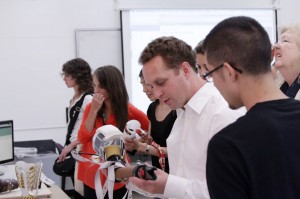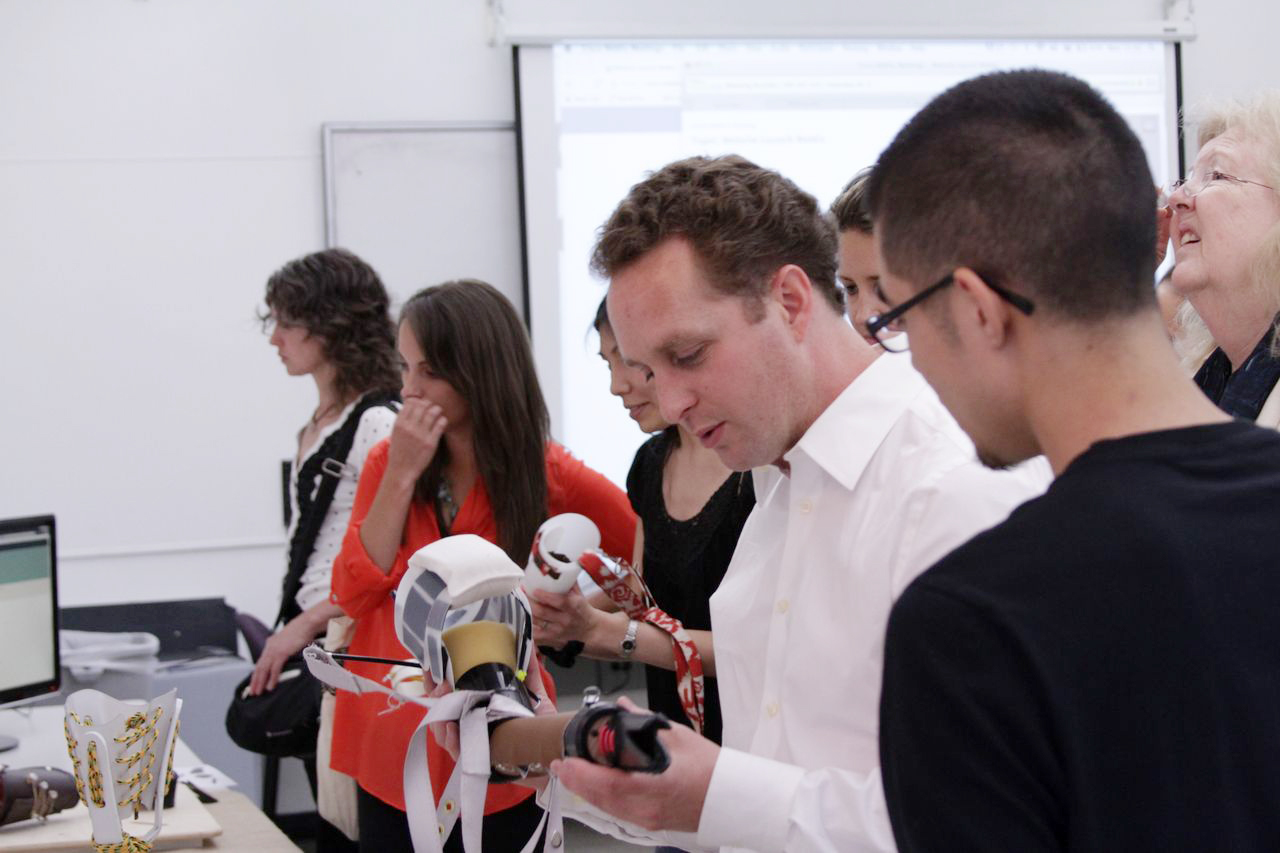
Students showcase Simple Limb Initiative prosthetic limbs that they created and interact with guests at an open house event (Randy Leu photo).
What can you do with $30? How about creating a life-altering device for a child who lost a limb in a landmine explosion? This was both the mission and the challenge for a group of industrial design students, who introduced their completed projects at a May 13 open house.
Poster boards lined the walls of an Art Building room with different prosthetic limbs for above and below the elbow amputations and above and below the knee amputations. Three countries, among the most affected by landmines, were represented: Afghanistan, Cambodia and Colombia.
Corey Higham, a junior industrial design major, showed a prosthetic leg that he designed and built out of materials including PVC pipes, bike tires and rubber washers.
“I’m proud of the work that we’ve done,” he said. “It was a lot of work. I think we’ve come up with a lot of creative solutions that can be useful.”
Introducing Simple Limb Initiative
Computer monitors throughout the room displayed a website created by senior graphic design students, recognizing the launch of Simple Limb Initiative. This is a collaboration between SJSU Associate Professor Leslie Speer and Professor Gerhard Reichert of HfG Schwäbisch Gmünd, a university in Germany. Reichert had applied to be a visiting scholar to SJSU from December 2012 to February 2013. One of his proposed workshops focused on affordable prosthetic limbs, catching Speer’s eye.
“The area of research that I focus on is ‘design for the majority,’ problems of the world that affect great numbers of people,” she said.
According to a project brief that the two professors presented on the first day of class, children are among the most affected victims of landmines worldwide. The loss of a limb can be devastating for people in developing countries. A typical prosthetic limb costs thousands of dollars, whereas Speer said, “A lot of people in impoverished parts of the world earn less than a dollar a day.”
For this semester-long project, industrial design students kept in mind using raw materials that were cost effective and readily available or attainable in their assigned countries. The prostheses had to be functional in the countries’ natural terrains and for the cultural lifestyles, whether it’s working in the fields or praying five times per day. The countries’ residents have to be able to make simple fixes and adjustments to the prosthetic limbs when necessary, and the aesthetically and ergonomically sound prostheses have to be adaptable to a child’s growing body.
“It was a really big learning curve, but it was a really beneficial learning curve,” said Irene Rose, a senior industrial design major. “You step outside of your comfort zone and walk in other people’s shoes.”
Making Connections
The entire process involved several stages of research, evaluating and testing. Industrial design students reached out to relevant organizations and groups in their assigned countries. They also received support closer to home, including testing out their work on people who have undergone amputations. Occupational therapy students, led by Professor Heidi Pendleton, provided insights into the technical and medical aspects of these patients.
This cross-disciplinary interaction is what Speer would like to continue encouraging in the future. The Simple Limb Initiative could eventually become a continuous university-based research initiative involving departments all across campus, such as occupational therapy, engineering, business and graphic design, as well as Reichert’s classes in Germany.
A spirit of generosity presents itself on the initiative’s website, which features manuals and diagrams for each of the prosthetic limbs. The intention is to make the information open source to encourage others to build and build upon these ideas.
One Spartan alumnus whose work already focuses on prosthetic limbs invited the students to visit his workplace. Scott Summit, ’94, Industrial Design is co-founder of Bespoke Innovations, which uses 3D printing to create customized coverings for prosthetic limbs. Summit and his colleague Chad Crittendon attended the open house.
Complex Balance
“I was impressed by the range and thoughtfulness that went into the projects,” Summit said. “Many of them managed to achieve a complex balance of cost, human need and design. I appreciate the devotion that went into their work, and I especially applaud Leslie for taking on such a challenging topic and handling it so superbly.”

